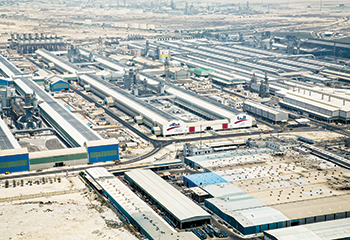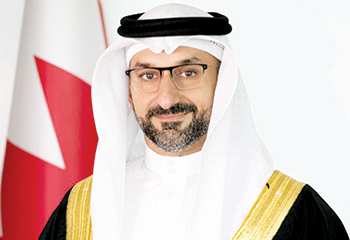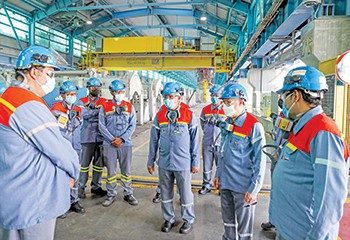
 Alba is a key enabler for a thriving downstream sector
Alba is a key enabler for a thriving downstream sector
Bahrain has a fairly impressive record of diversification and is, in fact, home to an established and varied manufacturing sector, with several heavy industries (aluminium, petroleum refining and petrochemicals) and a growing cluster of light manufacturing, such as food processing, fast moving consumer goods.
The kingdom’s quest for diversification and shift towards less reliance on oil gained further momentum this year with new initiatives which included the launch of the Industrial Sector Strategy 2022-2026 (late December 2021).
The new strategy primarily seeks to facilitate the expansion and diversification of national production, and in the long run, focus on developing an advanced, innovative and sustainable industrial sector.
NEW INDUSTRIAL STRATEGY
 |
|
Bahrain’s new Logistics Services Sector Strategy is designed to uplift the Kingdom’s logistical capacity across several services |
The Industrial Sector Strategy (2022-26), launched as part of Bahrain’s Economic Recovery Plan, aims to attract international investment, through the development of new and expanded industrial parks in Bahrain (US Trade Zone and the expansion of Sitra Industrial Park). Such plans will increase the allocated land for manufacturing, encourage technological infrastructure, as well as increase the sector’s contribution to the kingdom’s GDP.
In clear terms, by 2026 it aims to increase the industrial sector’s GDP contribution to BD2.5 billion ($6.6 billion); raise the proportion of industrial exports from its 2019 level of one-third of the total to 80 per cent, amounting to BD2.475 billion by 2026; and raise Bahraini employment in the sector to 25.3 per cent of the total.
Advancing Bahrain’s Industry 4.0 capabilities and investing in a circular carbon economy are other central goals of the new strategy, alongside encouraging investment in digital and technological products and solutions, and strengthening industrial infrastructure and local value chains.
With regards to promoting local industries, the strategy aims to strengthen national industries and develop initiatives to assist industrial small and medium-sized enterprises (SMEs) with initiatives ranging from launching programmes to encourage large factories to purchase products and services from local small and medium factories, providing industrial incubation and acceleration opportunities, improving regional import and export supply chains through Export Bahrain solutions, developing the “Made in Bahrain” trademark, and launching the Industrial Excellence Award to encourage competition amongst the factories.
Several investment projects will be implemented with the launch of the strategy, including the United States Trade Zone (USTZ) with an area of 1.1 million sq m at a cost of BD75 million and the Fasht Aladham industrial zone, with a total area of 104 million sq m, and the Aluminum transformative industry plot with an area of 477,000 sq m.
The strategy has also listed several infrastructure development projects. These include developing the infrastructure of East Salman Industrial City with an expected completion date in March 2024; and the infrastructure development in South Hidd Industrial Area.
MANUFACTURING GAINS
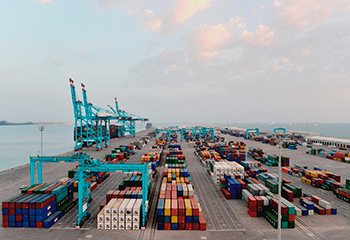 |
|
Bahrain: attracting investments |
The manufacturing sector contributed approximately 13.9 per cent of Bahrain’s real GDP in 2021, as reported by the Ministry of Finance and National Economy, making it the second largest non-oil sector following financial services. The sector is the third largest employer in the labour market, employing 11 per cent of the total work force in the private sector with a Bahrainisation rate of 24 per cent, according to Tamkeen, the government agency responsible for private sector development.
According to Macrotrends, a research platform for long term investors, Bahrain’s manufacturing output for 2021 was worth $7.82 billion, rebounding with a growth of 24.21 per cent over 2020 during which the sector contracted by 7.58 per cent at $6.29 billion.
This outcome was dominated by the contribution of the aluminium segment, Bahrain’s biggest non-oil export, and Aluminium Bahrain (Alba), which is integral to the overall industrial performance, achieving the highest production volumes in its history, at more than 1.5m tonnes in 2021.
Bahrain’s GDP growth accelerated to 6.9 per cent in the second quarter of 2022 from 5.4 per cent in the first quarter 2022 to record the highest rate of growth in the past 11 years, driven by a strong performance in the country’s non-oil sectors involved in the country’s economic reform plan.
Data from the Ministry of Finance and National Economy shows the transport and communication industry jumped 15.1 per cent and the manufacturing sector grew 7.6 per cent, boosted by an increase in total production from Alba, the Bahrain Petroleum Company (Bapco) and Bahrain Natural Gas Company (Banagas).
Further, Bahrain’s trade sector grew by 7.5 per cent in the second quarter of this year, reflecting a rise in the value of point-of-sale and e-commerce transactions, the ministry said.
As for trade exchange partners, China regained its position as Bahrain’s top import partner, with the total value of imports reaching $543 million in Q4 of 2021. On the other hand, Saudi Arabia maintained its position as Bahrain’s top export market in Q4 of 2021, with a total export valued at $602 million.
EXPORTS MATTER
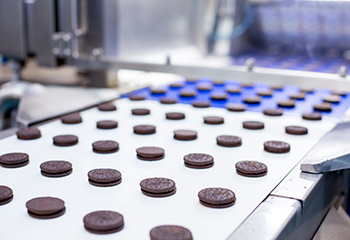 |
|
A file shot of facility of packaged food manufacturer Mondelez in Hidd, Bahrain |
In fact, export growth spearheaded a rebound in foreign trade volume following the easing of pressure in global supply chains. Bahrain’s total exports recorded $8.6 billion in June 2022, compared with $7.4 billion in the previous quarter, as per CEIC Data.
The value of Bahrain’s exports of national origin increased by 6 per cent to BD1.240 billion ($3.289 billion) during the third quarter 2022 (Q3), compared to BD1.174 billion for the same quarter of the previous year, said the Information & eGovernment Authority’s (iGA) foreign trade report of third quarter 2022.
The top 10 countries in terms of the value of exports of national origin purchased from Bahrain accounted for 77 per cent of the total value, with the remaining countries accounting for 23 per cent, said the report.
Saudi Arabia ranked first among countries receiving Bahraini exports of national origin, importing goods worth BD260 million from Bahrain. The US was second with BD171 million and the UAE third with BD139 million.
Unwrought aluminum alloys emerged as the top products exported during Q3 worth BD455 million, agglomerated iron ores and concentrates came second with a value of BD231 million, and aluminum wire (not alloyed) third with BD53 million.
The total value of re-exports increased by 1 per cent to reach BD177 million in Q3, compared to BD175 million for the same quarter of the previous year. The top 10 countries accounted for 80 per cent of the re-exported value, while the remaining countries accounted for the other 20 per cent. Saudi Arabia ranked first with BD38 million, the UAE second with BD37 million, and the UK third with BD14 million.
In terms of foreign direct investment (FDI), around BD1.9 billion ($5 billion), or 14.8 per cent, of the total BD12.5 billion ($33.2 billion) of FDI stock was invested in manufacturing enterprises in the third quarter of 2021. This was the second-highest total of all non-oil sectors, behind financial services, which accounted for 67 per cent.
More recent data shows Bahrain recorded $290 million in direct investment in the first three quarters of the year 2022, with 25 manufacturing and logistics companies setting up and expanding their businesses within the kingdom.
TWO PROJECTS DOMINATE
In the new set of things, to propel manufacturing sector growth, Bahrain is targeting specific segments including downstream aluminium and petrochemicals production, renewable energy components including blue and green hydrogen, pharmaceuticals, micro-electronic goods, food and fast-moving consumer goods.
Alba, the world’s largest single-site aluminum smelter outside of China, with its recent Line 6 expansion, is contributing to the pronounced growth in Bahrain’s non-oil merchandise exports.
In December, Alba signed up with Bechtel, a global leader in engineering, procurement and construction (EPC) sector, to conduct a feasibility study for its proposed Line 7 project. Expected to be completed in about 9 months, by September 2023, the study will provide a comprehensive evaluation of all factors to determine the viability of the Line 7 Project.
The company also recently flagged off work on a fourth block at the Power Station 5 which will add 680 MW scaling up its total capacity to 2,480 MW.
NEW INDUSTRIAL TRENDS
Likewise, the fast rise of environmental, social, and governance (ESG) and carbon net-zero factors are redefining and elevating sustainability in manufacturing in the kingdom.
For instance, companies like Taha International is developing the capability to recycle aluminium dross with almost no carbon emissions, utilising a technique that vastly outperforms other methods of dross recycling and results in 80 per cent less emission, according to an analysis conducted by EY for Taha.
With the transformative effects of solar power being recognised across the Gulf, the manufacture of solar technology is also gaining importance in the region. From the construction of a 100-MW solar park on top of a landfill site in Bahrain to moves by existing manufacturers like Arla Foods to green their electricity supply, companies are driving the installation of solar technology in the kingdom.
Using cloud technologies to increase efficiencies is also an important part of sustainable action. Mondelèz International, for example, has developed a cloud-based technology that helps the company efficiently monitor the use of water, electricity and natural gas at its Bahrain factory. The data is available in real time and can be readily compared with sustainability benchmarks, with positive improvements already being noted – CO2 emissions from the factory were down 65 per cent in 2020 compared to 2018, with a 70 per cent reduction in total waste for the same period.
Acceleration in automated and digital technology adoption amongst manufacturing businesses continue to increase from isolated in-house technology projects to full production lines or factories. There is a notable increase in new types of smarter light manufacturing such as food and beverage, consumer goods and the growing popularity of solar panels.

